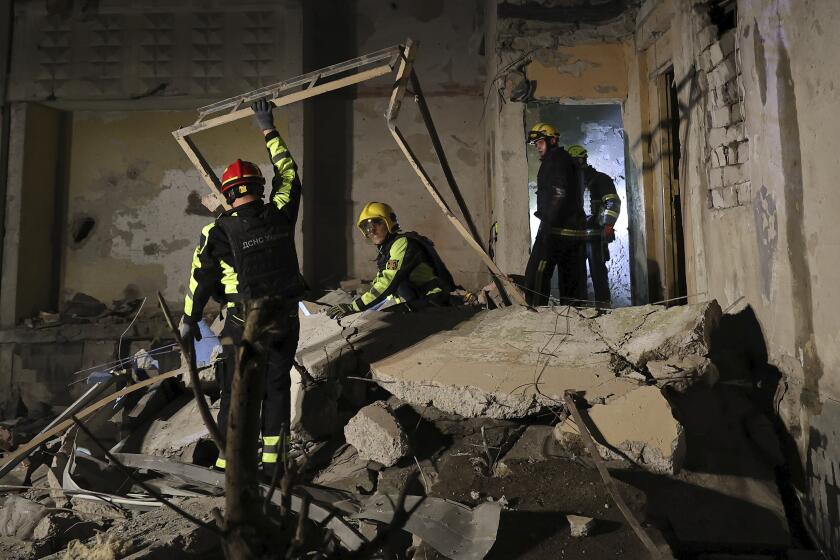Burned Part of Right Booster Recovered
A much-sought-after section of Challenger’s right booster rocket, part of the joint that leaked superhot gases blamed for causing the shuttle’s explosion, has been recovered by salvagers, the Navy reported Monday.
The joint shows evidence of burning--a hole one foot high and two feet across--and it is possibly the most vital piece of evidence yet retrieved from the Jan. 28 disaster.
The two-ton chunk of debris contains the aft center segment of the solid-fuel rocket, where a plume of smoke appeared during liftoff. The section was discovered 35 nautical miles northeast of Cape Canaveral in 560 feet of water.
‘Of Critical Interest’
The recovery was first announced in a statement by the presidential shuttle commission. Its chairman, William P. Rogers, called the find “one of two sections of critical interest” in the investigation of Challenger’s explosion.
“A burned-out area of the joint tang at about the 300-degree position is evident,” the statement read.
The tang is the lower part of the aft center segment. It fits into the clevis--the U-shaped top part of the aft segment. The clevis portion of the joint at the area of the leak has yet to be recovered.
May Not Be Nearby
“The way all the debris has been scattered, (the clevis) may not be nearby at all,” said Lt. Cmdr. Deborah Burnette, a Navy spokeswoman for salvage operations. “Or it might be a mile away, which to the salvagers is close.”
Investigators have said that rupture of this joint caused the disaster that killed the seven crew members. But they are unsure how it failed. Sophisticated metallurgical and chemical tests of the wreckage may allow engineers to pinpoint the reason.
J. R. Thompson Jr., vice chairman of the NASA task force working with the commission, said last week that the investigation is focusing on possibly defective O-rings designed to stop hot gases from escaping through the joint; on the effect of the rotation of the joint when subjected to ignition pressures; on characteristics of the putty intended to put pressure on the rings; a possible joint alignment problem, and the effect the freezing temperatures and high winds aloft on launch day might have had on the rings or the putty.
10 Possible Alterations
Answers are crucial toward redesign of the joint. Last week, James E. Kingsbury, head of engineering at NASA’s Marshall Space Flight Center in Huntsville, Ala., said 10 possible alterations to the joint are being considered.
Investigators had despaired of finding this puzzle piece because of fears that the burn-through had destroyed it. The 10-by-20-foot section was retrieved at 5 a.m. Sunday by the robot submarine Gemini and the Stena Workhorse, a contract salvage ship.
One of 677 Soundings
The section was first spotted by sonar on March 1, Burnette said. But it was only one of 677 soundings that have required a further look, and some of the sonar contacts have turned out to be nothing more than oil drums or scrap metal.
A research submarine did not make a videotape of the area until April 5. The tape was analyzed five days later.
“Based on the videotape, it looked like something we really wanted,” Burnette said. “We decided: Let’s get it, right now.”
The wreckage is expected to be brought ashore by early today.
Commission member Eugene E. Covert, a professor of aeronautics at the Massachusetts Institute of Technology, and some of the commission staff have gone to the Florida space center to inspect the vital evidence.
NASA’s acting administrator, William R. Graham, and Rear Adm. Richard H. Truly, the agency’s shuttle director, are scheduled to be briefed today by the NASA task force that has been making its own inquiry into the disaster.
The task force is scheduled to give a preliminary report to the shuttle commission later this week.
More to Read
Sign up for Essential California
The most important California stories and recommendations in your inbox every morning.
You may occasionally receive promotional content from the Los Angeles Times.









